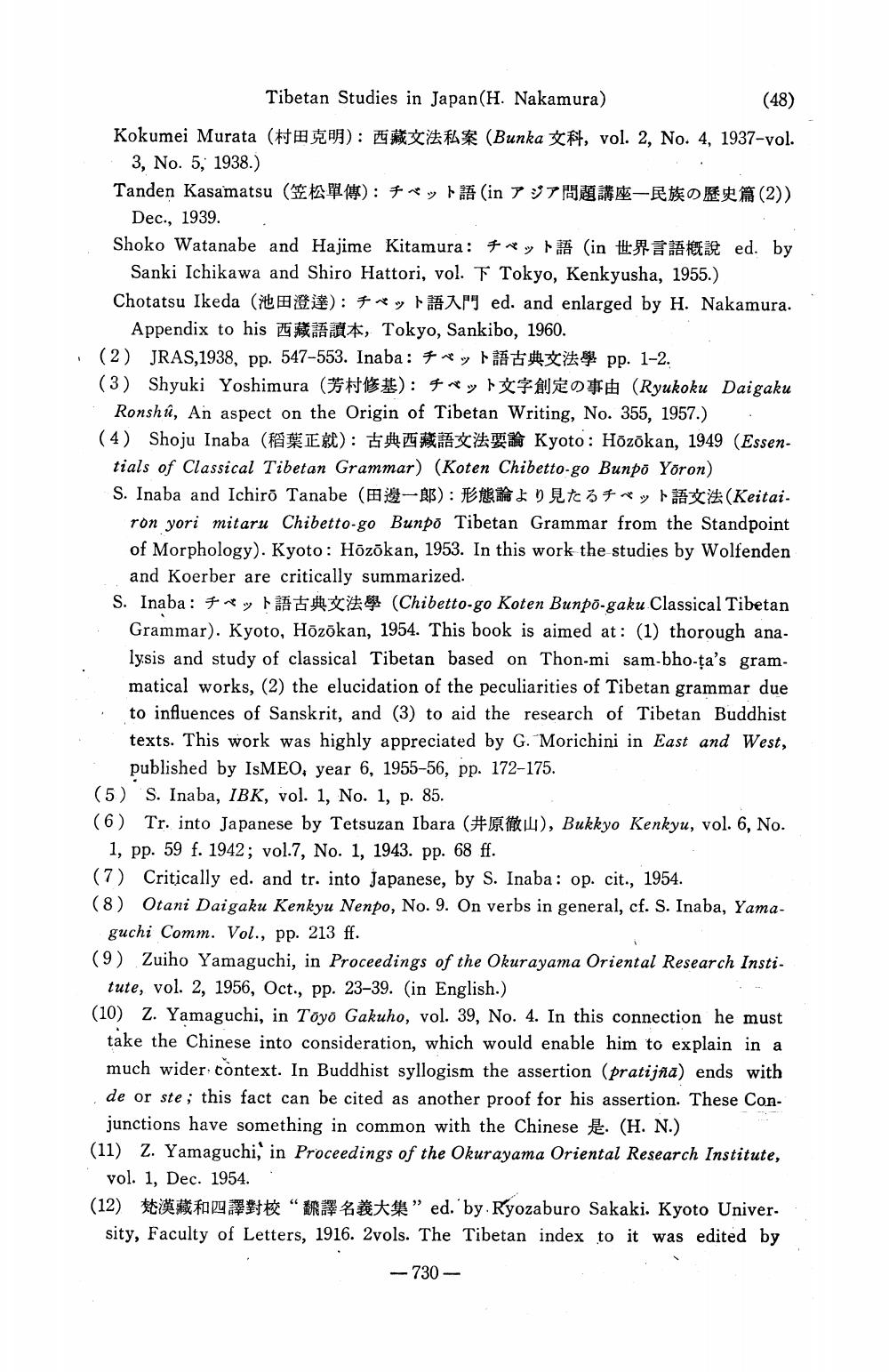________________
Tibetan Studies in Japan(H. Nakamura)
(48) Kokumei Murata (FEED): #TEA (Bunka , vol. 2, No. 4, 1937-vol.
3, No. 5, 1938.) Tanden Kasamatsu (A ): + (in 7 7H -EHEDUM (2))
Dec., 1939. Shoko Watanabe and Hajime Kitamura: 7 m (in R
e d. by Sanki Ichikawa and Shiro Hattori, vol. T Tokyo, Kenkyusha, 1955.) Chotatsu Ikeda (i ): 7 M M ed. and enlarged by H. Nakamura.
Appendix to his m u , Tokyo, Sankibo, 1960. (2) JRAS,1938, pp. 547-553. Inaba : ** #*#* pp. 1-2. (3) Shyuki Yoshimura (WB): 4* **AEDT (Ryukoku Daigaku
Ronshủ, An aspect on the Origin of Tibetan Writing, No. 355, 1957.) (4) Shoju Inaba (FEEL): #L AKE Kyoto: Hõzõkan, 1949 (Essentials of Classical Tibetan Grammar) (Koten Chibetto-go Bunpö Yöron) S. Inaba and Ichiro Tanabe (
H B ): V
ltc 27 g * (Keitai. ron yori mitaru Chibetto-go Bunpo Tibetan Grammar from the Standpoint of Morphology). Kyoto: Hözökan, 1953. In this work the studies by Wolfenden
and Koerber are critically summarized. S. Inaba: 7 ng ATS (Chibetto-go Koten Bunpo-gaku Classical Tibetan Grammar). Kyoto, Hözökan, 1954. This book is aimed at: (1) thorough analysis and study of classical Tibetan based on Thon-mi sam-bho-ta's grammatical works, (2) the elucidation of the peculiarities of Tibetan grammar due to influences of Sanskrit, and (3) to aid the research of Tibetan Buddhist texts. This work was highly appreciated by G. Morichini in East and West,
published by ISMEO, year 6, 1955-56, pp. 172-175. (5) S. Inaba, IBK, vol. 1, No. 1, p. 85. (6) Tr. into Japanese by Tetsuzan Ibara ( LI), Bukkyo Kenkyu, vol. 6, No.
1, pp. 59 f. 1942; vol.7, No. 1, 1943. pp. 68 ff. (7) Critically ed. and tr. into Japanese, by S. Inaba : op. cit., 1954. (8) Otani Daigaku Kenkyu Nenpo, No. 9. On verbs in general, cf. S. Inaba, Yama
guchi Comm. Vol., pp. 213 ff. (9) Zuiho Yamaguchi, in Proceedings of the Okurayama Oriental Research Insti
tute, vol. 2, 1956, Oct., pp. 23-39. (in English.) (10) Z. Yamaguchi, in Toyo Gakuho, vol. 39, No. 4. In this connection he must
take the Chinese into consideration, which would enable him to explain in a much wider context. In Buddhist syllogism the assertion (pratijña) ends with de or ste; this fact can be cited as another proof for his assertion. These Con
junctions have something in common with the Chinese (H. N.) (11) Z. Yamaguchi, in Proceedings of the Okurayama Oriental Research Institute,
vol. 1, Dec. 1954.. (12) o t WRX A#" ed. by Ryozaburo Sakaki. Kyoto Univer. sity, Faculty of Letters, 1916. 2vols. The Tibetan index to it was edited by
-730




